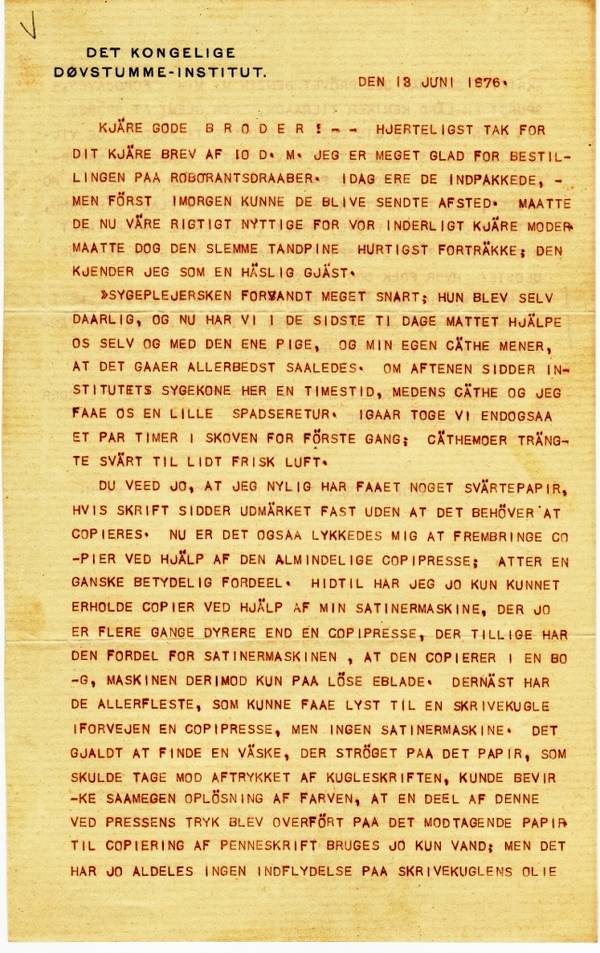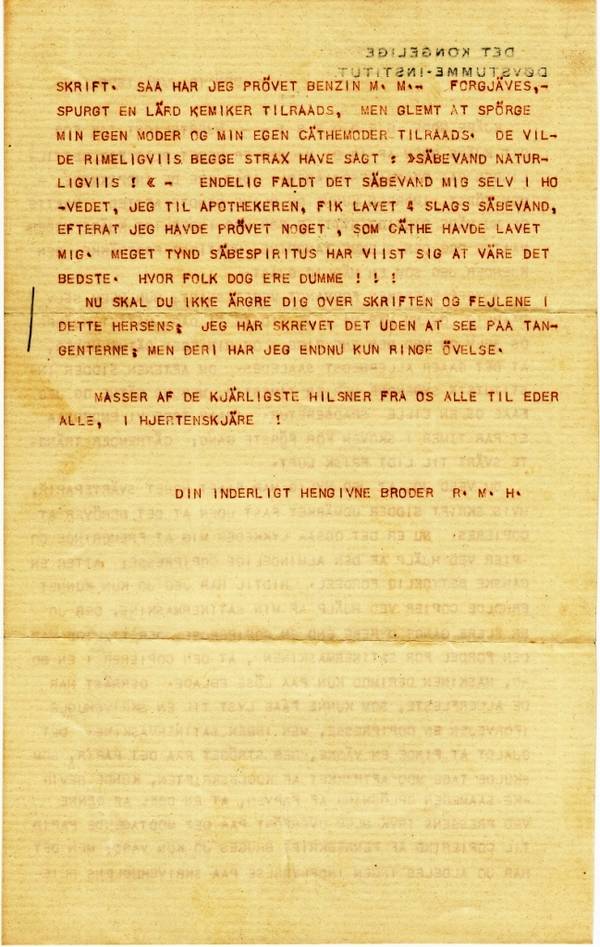1876.06.13 English
THE ROYAL INSTITUTE FOR THE DEAF-MUTE
JUNE 13, 1876
MY DEAR B R O T H E R ! _ _ WARMEST THANKS FOR YOUR DEAR LETTER OF JUNE 10. I AM VERY PLEASED WITH YOUR ORDER OF ROBORANT DROPS. THEY HAVE BEEN WRAPPED IN TODAY, - BUT WE CANNOT SEND THEM UNTIL TOMORROW. I DO HOPE THEY WILL BE TRULY BENEFICIAL FOR OUR DEAR BELOVED MOTHER. MAY THE BAD TOOTH-ACHE CLEAR OUT QUICKLY; I KNOW THAT ONE AS A TERRIBLE GUEST.
THE NURSE DISAPPEARED VERY QUICKLY; SHE HERSELF WAS TAKEN ILL, AND NOW FOR THE LAST TEN DAYS WE HAVE HAD TO DO WITH ONE MAID ONLY, AND MY DEAR CÄTHE FINDS THAT THINGS ARE RUNNING BEST THAT WAY. IN THE EVENINGS, THE SICK-BERTH ATTENDANT OF THE INSTITUTE IS HERE FOR AN HOUR OR SO, WHILE CÄTHE AND I GO FOR A SHORT WALK. YESTERDAY WE EVEN VENTURED INTO THE FOREST FOR A COUPLE OF HOURS FOR THE FIRST TIME; DEAR CÄTHE NEEDED SO MUCH A BIT OF FRESH AIR.
YOU KNOW, OF COURSE, THAT RECENTLY I GOT SOME CARBON PAPER, WHERE THE TYPING IS VERY WELL FIXED WITHOUT THE NEED FOR BEING COPIED. NOW I HAVE ALSO SUCCEEDED IN PRODUCING COPIES BY MEANS OF THE ORDINARY COPYING PRESS; THIS IS ANOTHER RATHER BIG ADVANTAGE. UP UNTIL NOW, I HAVE ONLY BEEN ABLE TO PRODUCE COPIES BY MEANS OF MY SATINER MACHINE[1], WHICH IS OF COURSE MUCH MORE EXPENSIVE THAN THE COPYING PRESS, WHICH ADDITIONALLY HAS THE ADVANTAGE IN RELATION TO THE SATINER MACHINE, THAT IT IS ABLE TO MAKE COPIES INTO A BOOK[2], WHILE THE SATINER MACHINE CAN ONLY COPY ONTO LOOSE SHEETS.
IN ADDITION, MOST OF THE PEOPLE WHO MIGHT WISH TO GET A WRITING BALL WILL ALREADY BE IN POSSESSION OF A COPYING PRESS[3] , BUT NOT A SATINER MACHINE. THE CHALLENGE WAS TO FIND A LIQUID WHICH, APPLIED ON THE PIECE OF PAPER THAT WAS TO ABSORB THE IMPRINT OF THE BALL WRITING, COULD ACCOMPLISH SO MUCH DISSOLUTION OF THE COLOUR THAT BY MEANS OF THE PRESSURE OF THE PRINTING PROCESS PART OF THIS COLOUR COULD BE TRANSFERRED TO THE RECEIVING PAPER. FOR COPYING OF PEN WRITING WE USE ONLY WATER; BUT WATER HAS NO INFLUENCE AT ALL ON THE OIL-BASED WRITING OF THE WRITING BALL. I HAVE BEEN EXPERIMENTING WITH PETROL AND MANY OTHER LIQUIDS, BUT IN VAIN. I HAVE ALSO CONSULTED AN ERUDITE CHEMIST, BUT ALAS FORGOTTEN TO ASK MY OWN MOTHER AND MY DEAR CÄTHE FOR THEIR ADVICE. PRESUMABLY BOTH OF THEM WOULD IMMEDIATELY HAVE SAID: “SOAPY WATER, OF COURSE!” FINALLY, IT DID OCCUR TO ME TO USE SOAPY WATER, AND I WENT TO THE CHEMIST, HAD 4 DIFFERENT KINDS OF SOAPY WATER MADE, AFTER HAVING ALSO TRIED SOMETHING THAT CÄTHE HAD MADE FOR ME. A VERY THIN DISSOLUTION OF SOAPY SPIRITS HAS PROVEN TO BE THE BEST. PEOPLE REALLY ARE STUPID ! ! !
PLEASE DON’T BE BOTHERED BY THE WRITING AND THE ERRORS IN THIS LETTER; I HAVE TYPED IT WITHOUT LOOKING AT THE KEYS[4]; HOWEVER, SO FAR I HAVE HAD VERY LITTLE PRACTICE IN THAT TECHNIQUE.
LOTS OF WARMEST GREETINGS FROM ALL OF US TO ALL OF YOU DEAR PEOPLE !
YOUR DEEPLY DEVOTED BROTHER R.M.H.
[1] JMC: A “Satiner Machine” was, at the time, obviously an expensive and elaborate way of copying pictures and text. The term Satiner machine is still is use, but now it denotes a machine for printing of patterns on tiles.
[2] CB: At this point I could easily write a footnote of 5 pages (Well, with Sverre’s recent information it almost tallies!) As we know, in 1872 RMH had ‘invented’ Xerography – a word he himself coined and which has Greek origins, ‘xeros’ meaning ‘dry’ and ‘graphos’ meaning ‘writing’. He publicised this in extensive articles which were spread the world over, but later on were so utterly forgotten by everybody, that the Xerox-group of companies are denying this. Hence, officially, Xerography was not invented until 1939. (JMC: according to the English version of Wikipedia, it was the American Chester Carlson who invented the method in 1938 and achieved an American patent for it in 1942).
By means of the Xerographic method used by RMH it was possible, if I have understood correctly, for the first time ever to produce many copies of a document, without having to get it printed at a printing shop. In short, RMH achieved this by simultaneously inserting 5 pieces of paper and 5 pieces of carbon paper with the carbonized side upwards, into the writing ball. In this way, when he had typed a letter he got 5 laterally reversed copies of the text.
His next step was to insert new paper sheets between the 5 sheets with laterally reversed text and put them through a press, called a satiner machine, and which then would produce 5 complete copies of his letter. He also discovered that the colour “Berliner Blau” – documented by Dieter Eberwein – was particularly effective for carbon paper, enabling him to re-use de 5 pieces of carbon paper 15 to 20 times and hence produce 100 copies in a few minutes.
SA: AS far as I have understood, the 5 pieces of paper that he started off with were a special kind of “oily” paper. RMH has further related that he can now use an ordinary copying press for for this type of copying, if he he applies soapy water of a particular dissolution onto the oily paper. Otherwise he had used a satiner machine, which procedure was much more costly than a copying press.
CB: The implication must be – and this is a surprise to me – that there were already ‘copying machines’ around. In other words, that it is not an invention by RMH!
[3] SA: In my view, the brilliant aspect of RMH’s discovery was that he not only copied a letter but found out how to make the laterally reversed copies, which he subsequently ran through the copying press and produced 5 copies each time, where nobody before him had considered the possibility of making more than one single copy.
[4] CB: This excuse is quite superfluous, because it is a very beautiful letter from a graphic point of view, and deeply impressive that it was done by touch-typing - possibly the first such letter in the world? I wonder why he did it that way – was he maybe following a manuscript while typing? SA: Perhaps he simply wanted to try and see if he was able to type without looking at the keys?


